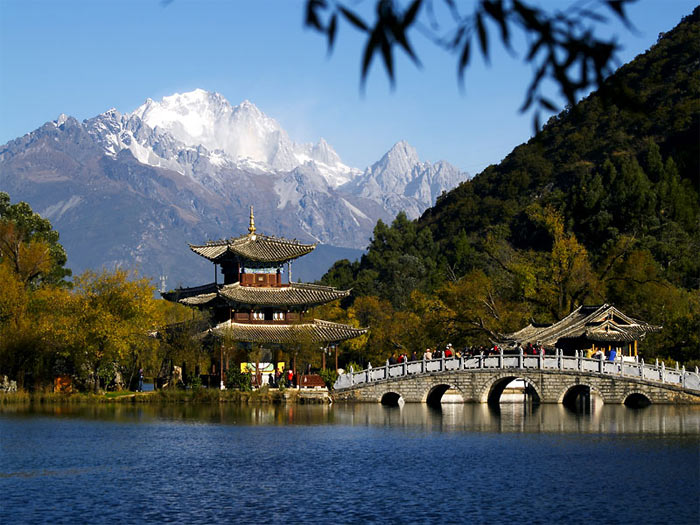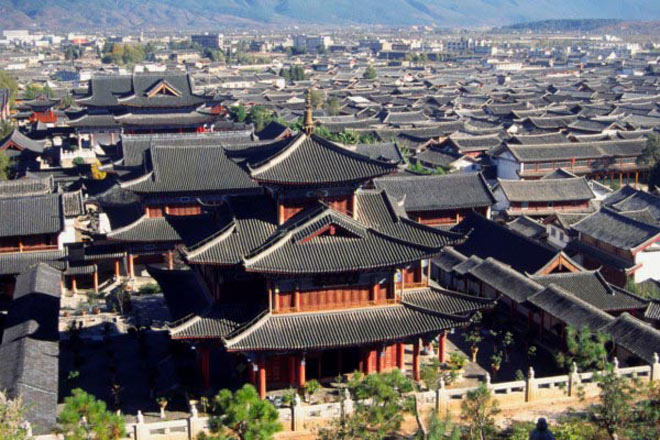Lijiang town
Unesco's Scientific, Educational and Cultural Organization has recognized China's Lijiang Citadel as the World Cultural Heritage in 1997, during the 21st session. By 2012, Lijiang Ancient again recognized again with some additional criteria.

Lijiang Citadel is located in Naxi District - an autonomous district of Yunnan Province in the southwestern part of China. The ancient citadel began to be built at the end of the Song and early Nguyen dynasties (late 3rd century BC). The ancient citadel is located on the Guizhou plateau, with a height of more than 2400 meters above sea level, with an area of 3.8 km2. According to the history of the time when the city was not built, this was an important area and a place to gather many markets with towns. Currently there are more than 6,200 households in the city, with more than 25,000 people. In which Naxi ethnic people occupy the majority, 30% of the people here still do crafts such as bronze, silver, tanning and fur making, alcohol distillation and trade.

The streets of Le Giang ancient city are bordered by mountains near the river, red rocks, the rainy season is not muddy, the dry season is not dusty, the patterns on the stone surface of the road surface look natural and elegant, very harmonious with the environment of this ancient citadel.Tu Phuong Street in the center of the ancient city is the typical old town of Le Giang ancient city.

On the Ngoc Ha river system in Le Giang city, there are 354 bridges, making the average density calculated for every 1 km square in the city has more than 10 bridges. The shape of the bridge is very diverse with famous bridge projections such as Ta Thuy Bridge, Dai Thach Bridge, Nam Mon Bridge, Ma Yen Bridge, Nhan Tho Bridge . These bridges were built in the Ming and Thanh Dynasty ( from the 14th to the 19th century. Among them, Dai Thach Bridge is about 100m from Tu Phuong Street, the most special.
Covering Moc family in Le Giang citadel, which is the mansion of Moc village, this is the head of Le Giang old. The palace was built during the Nguyen Dynasty. In 1998 after being rebuilt, the government became a museum in the ancient city. The area of the Moc phu area is 46 acres, with a total of 162 large and small houses. There are 11 signs left by the kings, reflecting the flourishing history of the Moc family.

In Le Giang ancient citadel, Phuc Quoc pagoda with Ngu Phuong building was built in the 29th year of the Minh Dynasty (1601), this floor is 20m high. Due to the appearance of the bridge like the five phoenixes flying from afar, it was called " Ngu Phuong floor ", and on the ceiling in the floor, there were many beautiful pictures. Ngu Phuong floor is designed in the architectural style of the ethnic Han, Tibet, NaXi, this is a typical architecture in ancient Chinese architecture.
 Symbol of Lijiang, water wheel at Ngoc Ha Square
Symbol of Lijiang, water wheel at Ngoc Ha Square
The architecture of Bach Sa residential area is 8km north of Lijiang city, this is the political, economic and cultural center of Le Giang area during the Song Dynasty to the Nguyen Dynasty (10th century to the 10th century). 14). This architectural cluster is distributed on the main axis of the route from south to north, the center is a trapezoidal square, a stream from the north flows through the square, and also from here the street radiates in the direction with a bold style local. The formation of the Bach Sa residential architecture cluster has laid the foundation for the layout of Le Giang ancient city. The residential architecture cluster at Thuc Ha is four kilometers northwest of Lijiang town, the small town next to the ancient citadel, the houses of this architectural cluster are different and low, its composition resembles Tu Phuong street. The Thanh Long River flows through the middle of this architectural cluster with the Thanh Long Bridge built in the Nguyen Dynasty. Thanh Long Bridge is also the largest bridge of Lijiang.
Le Giang Citadel has the layout of an ancient city that naturally bobs but still has a lot of ways. Le Giang residents integrate the elite of the Han, Bach, Di, and Tibetan peoples and the Naxi style. This is an important and rare heritage to study the history of architecture and history and at the same time have the social life of Chinese people.
The roofs and pillars of the old houses in Lijiang are all built from wood and brick. Most houses have hanging lanterns to create a beautiful picture of color.

Not only that, Lijiang ancient citadel is a famous historical and cultural city with a relatively high value and a relatively high value, the ancient city focuses on expressing the culture and history of the native as well as the practice style. customs of the nation, which characterized the nature of social progress at that time. The city space is mobile, the river system is full of life, the architecture group has a unified style, the architecture of the housing is of appropriate size, the environment is close and pleasant and the content of the people art The ethnic group has a unique style, making Le Giang ancient citadel become a famous cultural and historical city. The most remarkable feature of architecture in the ancient citadel is natural, requires practical efficiency. This is also a traditional concentration of ethnic minorities. The existence of this ancient city provides a lot of important data for the study of history, culture, and the development of ethnic minorities and is an important cultural heritage of China.

At the meeting to assess the results of the Unesco World Organization, it was identified: Le Giang Ancient City has cleverly reconciled the economic and strategic focus with the rugged terrain, preserving and revealing the ancient face of into the neck honestly and flawlessly. The architecture of the ancient citadel has undergone many challenges of people and nature for centuries, but still retains its unique beauty while promoting its role in life in a very effective way.



- Strange towns in the world
- 9 beautiful Chinese towns
- The most mysterious ghost towns on earth
- Ghost town emerged from the water
- Beautiful architecture of the world's most colorful town
- The 'winter paradise' makes you ecstatic
- Discover the oldest prehistoric town in Europe
- 3500 people live in the underground town in Australia
- 'Ghost town' in Australia, where breathing can also be deadly
- The first 'Wikipedia' town in the world
- Unbelievable but true story: To live here, you have to cut the appendix
- America: Vortex flattening a town
 Suzhou classic bonsai garden - China
Suzhou classic bonsai garden - China Chau Nguyen Dynasty
Chau Nguyen Dynasty Thai Son Mountain - World Wonder
Thai Son Mountain - World Wonder Ancient villages of Shirakawa-go and Gokayama
Ancient villages of Shirakawa-go and Gokayama 'Miracle sex drug' revived after 2,000 years of extinction, surprising effects
'Miracle sex drug' revived after 2,000 years of extinction, surprising effects  After 1,800 years, ghosts from ancient Mayan cities are still enough to harm people
After 1,800 years, ghosts from ancient Mayan cities are still enough to harm people  How advanced were prehistoric civilizations?
How advanced were prehistoric civilizations?  The mystery of the 4,000-year-old nuclear explosion at India's 'hill of death'!
The mystery of the 4,000-year-old nuclear explosion at India's 'hill of death'!  Why do archaeologists absolutely not touch two 'colorful' things in ancient tombs?
Why do archaeologists absolutely not touch two 'colorful' things in ancient tombs?  What is the difference between Western eunuchs and Chinese eunuchs?
What is the difference between Western eunuchs and Chinese eunuchs? 